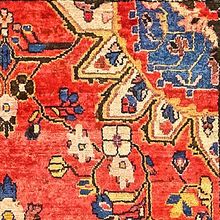Difference between revisions of "Mehraban Rug"
| Line 64: | Line 64: | ||
== Bibliography == | == Bibliography == | ||
* Abraham Levi Moheban, (2015), ''[[The Encyclopedia of Antique Carpets|The Encyclopedia of Antique Carpets: Twenty-Five Centuries of Weaving]]'', NewYork: Princeton Architectural Press. | * Abraham Levi Moheban, (2015), ''[[The Encyclopedia of Antique Carpets|The Encyclopedia of Antique Carpets: Twenty-Five Centuries of Weaving]]'', NewYork: Princeton Architectural Press. | ||
| + | [[Category:Hamadan Rug and Carpet]] | ||
[[Category:Persian Rug and Carpet]] | [[Category:Persian Rug and Carpet]] | ||
[[Category:Rug and Carpet]] | [[Category:Rug and Carpet]] | ||
[[fa:قالی_مهربان]] | [[fa:قالی_مهربان]] | ||
Revision as of 13:32, 28 January 2020
| Mehraban Rug | |
|---|---|
 Design of Mehraban Rug (Rugman) | |
| General information | |
| Name | Mehraban Rug |
| Original name | قالی مهربان |
| Alternative name(s) | Mehraban Carpet (Mousel Rug) |
| Origin | |
| Category | Village |
| Technical information | |
| Common designs | Vagireh, Herati, Geometric |
| Common colors | Red, Blue, Navy Blue, Ivory, Brown, Beige, Yellow |
| Dyeing method | Natural, Synthetic |
| Pile material | Wool |
| Foundation material | Cotton |
| Knot type | Symmetrical (Turkish) |
Mehraban is a district located in the north of Hamadan Province in western Iran. Mehraban rugs resemble in design and color those of the city of Sarab and the surrounding areas in northwestern Persia. It is believed that tribal movement from northwestern Persia to Hamadan’s Mehraban district occurred sometime in the past, but their weaving traditions still remained close.
History
Mehraban is a district located in the north of Hamadan Province in western Iran. Mehraban rugs resemble in design and color those of the city of Sarab and the surrounding areas in northwestern Persia. It is believed that tribal movement from northwestern Persia to Hamadan’s Mehraban district occurred sometime in the past, but their weaving traditions still remained close.
It is important to note that another city named Mehraban is located in the East Azerbaijan Province of northwestern Iran. East Azerbaijan Mehraban weavers followed the Heriz design style. The rugs woven in these identically named cities have different designs, technique, and coloration; there is no connection between them.
Hamadan Mehraban rugs are known in the antique market from the last quarter of the nineteenth century. The rugs are made in runner and gallery sizes in a variety of lengths, and as small tribal weavings six feet six inches by four feet six inches. The camel hair coloration in Mehraban runners is almost identical to Sarab runners, and it is difficult to distinguish a difference between them.
Early Mehraban rugs measuring approximately four feet by six feet can have a market value up to $8,000. By the late twentieth century, some Mehraban weavers converted from making traditional designs to produce rugs and carpets similar to other neighboring areas in response to the needs of consumers, both domestic and foreign.[1]
Materials
Foundation and Pile
The foundation is made with cotton and the pile is made with wool.[2]
Techniques and structures
Color and dyeing
Mehraban rug fields generally are colored in a characteristic camel hair or peach that distinguishes the rugs from other Hamadan-area weavings. In addition to these two colors, shades of blue, red, green, gray, gold, brown, and black are used for the borders, design elements, outlines, and, at times, the background. The camel hair coloration is often used as a plain outer border in framing the carpet.[3]
Motifs and Designs
The rug designs have a geometric, village style featuring multiple medallions with tribal ornaments and, at times, animal and bird motifs. Other Mehraban designs include the tribal palmette, leaves, and vines.[4]
Weaving techniques
The foundation is tied in the Turkish (symmetric) knot. The grade qualities of the weavings are generally good to fine.[5]
See also
Sarab Rug, Hamadan Rug, Heriz Rug
References
Bibliography
- Abraham Levi Moheban, (2015), The Encyclopedia of Antique Carpets: Twenty-Five Centuries of Weaving, NewYork: Princeton Architectural Press.